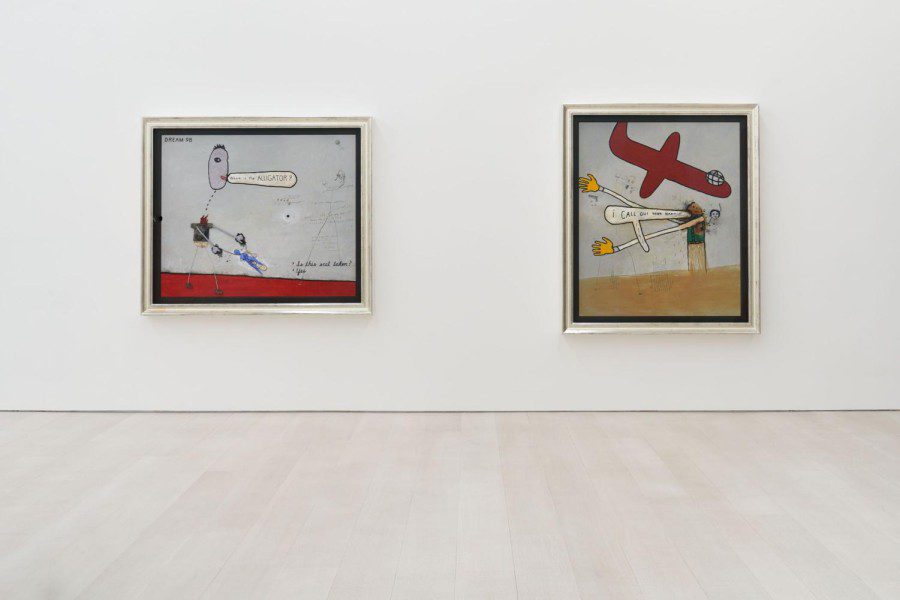For the first time, David Lynch gets weird on canvas
David Lynch’s “Big Bongo Night” is a mixed-media approach to the filmaker’s signature style. The exhibit is on view at Pace Gallery until Dec. 17.
November 30, 2022
Before he was a renowned filmmaker, David Lynch just wanted to paint. He only started making films out of a desire to see his paintings move; thus, his debut short “Six Men Getting Sick (Six Times)” saw the bizarre bodies that populate his paintings begin to do so. The film laid out his future not just as an auteur, but as a visual artist as well.
A selection of Lynch’s works from 2019 to 2022 are currently on view at Pace Gallery in Chelsea through Dec. 17. The installation displays almost a dozen multimedia works on paper, wood and canvas, as well as several lamps.
Though paint is the primary medium on display, it would be a misnomer to call the works exhibited paintings: clay, cheesecloth, animal skin, and Band-Aids all make an appearance. Lynch’s canvases are more akin to sculptures, displaying a melding of media that ruptures their flatness. In “Goodbye,” flat outlines give way to fabric arms and clay hands; in “Good Times on Our Street,” a 3D blood spurt flies from the eyeball of the smiling Bic blue doodle of a face.
Lynch has sculpted the works on canvas and paper to reveal their own construction. Cracked paint imbues the scenes with both a haptic decay and playful splotchiness, as if resisting the very notion of pristine beauty; globs of paint regularly pile into small hills. The viewer cannot recede into the comfort of distance, as each work confronts the viewer with its dimensionality.
Lynch relies heavily on the use of text in the works, incorporating the absurd not only into his visual repertoire but his inscribed dialogue as well: “eat shit dickhead,” a humanoid body declares as his disproportionately large hand points a silver clay gun at the composition’s other “character.” Lynch has taken the interplay between word and image into the realm of the comic book, often placing speech bubbles above painted figures parading through spectacular, cartoonish violence.
Throughout the exhibit, Lynch remains true to the humor that viewers might recognize from his directorial pursuits. Undercutting the exaggerated seriousness of the compositions with dry humor of the zany and sensational, his works play with the latent absurdity of the world. In “Duckman’s Gray-Dog Dream,” for instance, a cloudy background and bright red mountainous shapes give rise to, naturally, a giant duck head and a flying dog, the latter of which has three clay heads stuck on its mutilated back.
His art contains the same talent for imbuing the eccentric in the most mundane sentences of all: “The eggs are in a row / they are cracking open,” scribbled onto “Dream 9B: Where is the Alligator?,” might recall the rhythm of “The owls are not what they seem” from “Twin Peaks.” And in the corner of the canvas, so small it might almost go unnoticed, an arrow forms a line from a clay face, shaped resembling a fingerling potato, to a message scribbled in faded black ink: “What the Fuck?”
Nowhere in the works is the body fully formed. Limbs are mysteriously missing or about to be blown off, floating faces lurk ominously in corners, and discontinuities in media interrupt what might have been a human. Instead, the figurations march deliberately into the surreal. The shapes that Lynch returns to are biomorphic but disfigured, a post-industrial wasteland of deformed bodies, crashing airplanes, and the uncanny ruins of man and machine. Clay faces lit with a bubbliness that’s both amusing and unsettling emerge at random points on the canvas, as if trying to startle from a lucid dream.
In the middle of the room are a series of what Lynch describes as mixed-media lamp sculptures –– cylindrical orange light bulbs built into tall geometric constructions of metal and carved wood. Their arrangement atop a short platform suggests a bizarrely commercial display. Their minimalist craftsmanship has a formal balance; the lighting pieces are quite a jarring shift from the rest of the exhibit.
While the lamps call attention Lynch’s obsession with electricity, one that’s evident for anyone who has ever come across his work before, the sculptures lack the foreboding atmosphere and wit his other works radiate. If they contribute anything to the exhibit, it is their warm glow, their suggestion of interior design and formal harmony, that make the other works’ apocalyptic quirk even more unsettling.
“Big Bongo Night” nods to the haunted quality of his work just as much as their carnivalesque nature. Making their way through the room, viewers will find images of despair turned into irony, of vast desolation turned into tongue-in-cheek dreamscapes. The hypnotic quality of his oeuvre translates onto the canvas, captivating its audience with a phantasmagoric display of action, barbarity and hallucination.
Contact Katherine Williams at [email protected].



























































































































































